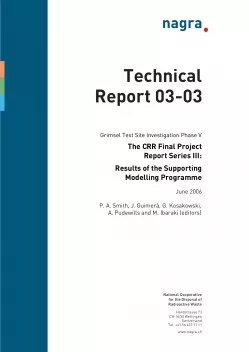
Technical Report NTB 03-03
Grimsel Test SiteInvestigation Phase VThe CRR Final Project Report Series III: Results of the Supporting Modelling Programme
The Colloid and Radionuclide Retardation Experiment (CRR) is dedicated to improving the understanding of the in situ retardation of safety-relevant actinides and fission products associated with bentonite colloids in the vicinity of the Engineered Barrier System (EBS)/host rock interface. In addition to a series of in situ dipole experiments that were carried out at the Grimsel Test Site (GTS), the project partners, namely ANDRA (F), ENRESA (E), FZK-INE (D), JNC (J), USDoE/Sandia (USA) and Nagra (CH), funded an extensive programme of laboratory and modelling investigations. The aims of CRR were: examination of the in situ migration of bentonite colloids in fractured rocks, investigation of the interactions between safety-relevant radionuclides and bentonite colloids in the laboratory and in situ and, in addition, the testing of the applicability of numerical codes for representing colloid-mediated radionuclide transport.
The present report is one of three final project reports that summarise the findings of the CRR project. In addition to this modelling report, the series includes reports on the field and laboratory work. This report summarises and discusses the results of the modelling investigations that were carried out by four teams (Enviros, FZK-INE, JNC and PSI) working largely independently with the aim of developing understanding of the structures and processes affecting tracer transport in the in situ field tests.
The modelling teams had access to the same set of field observations and supporting laboratory work and the models developed by the teams had many similarities. All of the models considered that radionuclide tracers could be transported either in solution or in association with colloids and all considered:
- advection and hydrodynamic dispersion of solutes and colloids in a fracture or fractures within the shear zone,
- retardation of solutes by sorption and / or matrix diffusion, and
- exclusion of colloids from rock matrix pores.
The most significant difference was probably the treatment of the interaction between solutes and colloids; the assumptions employed included equilibrium sorption, non-equilibrium sorption with first-order kinetics and irreversible sorption of radioactive tracers on colloids. A similar range of assumptions has been used in modelling colloid-facilitated radionuclide transport in recent repository safety assessments. There were also significant differences in the treatment of hydrodynamic dispersion, including its treatment as a diffusion-like process described by Fick's Laws and as a non-Fickian process, as well as a model that explicitly modelled the dispersion arising from a network of multiple orthogonal fractures.
The Enviros and PSI teams carried out some predictive modelling in advance of the main experimental runs in order to test their approaches and to aid in the planning of the experiments. Most of the modelling was, however, carried out after the main runs and involved a degree of inverse modelling. The success of some modelling approaches (and, equally importantly, the difficulties of others) in predicting or reproducing the experimental results enabled a number of conclusions to be drawn.
The CRR experiment and the modelling work discussed in this report indicate that, in the main experimental run #32 with bentonite colloids added to the injection cocktail:
- Am, Pu and Th were transported principally in association with colloids, and
- Cs was also transported in part in association with colloids, although the main part of the injected inventory was transported in solution.
Some radionuclides, including Am, Pu and Th, were also transported in colloidal form even when no colloids were added to the injection cocktail (run #31). The addition of bentonite colloids, however, increased recovery of these tracers. The role of colloids in the transport of Np and U in the two main runs was not unambiguously determined. Laboratory experiments, however, demonstrated that colloidal species are of minor relevance for Np(V) and U(VI).
Regarding processes:
- The narrowness of the experimental dipole flow field was such that tracer transport and breakthrough could be adequately treated with advection and dispersion modelled as 1 D processes along a direct line between the injection and withdrawal wells.
- Advection-dispersion models with matrix diffusion were adequate for modelling the breakthrough of conservative tracers and several sorbing tracers, confirming the findings of modelling studies in support of the earlier Migration Experiment (MI).
- Colloids (and tracers associated with them) were advected with little or no retardation and with a breakthrough peak that occurs slightly earlier than that of a conservative solute tracer, consistent with the assumption that colloids do not undergo significant matrix diffusion in the shear zone. The absence of matrix diffusion for colloids is also confirmed by unsuccessful attempts to reproduce the shapes of the tails of colloid breakthrough curves with physically plausible diffusion parameters, and by the fact that the shape of this tailing is independent of colloid size.
- The shapes of the tails of the colloid breakthrough curves suggest that Fick's Laws do not adequately describe dispersion in the shear zone and that a high degree of heterogeneity exists along the transport paths. For solutes, it has not been possible to distinguish the effects of possible non-Fickian dispersion from those of matrix diffusion.
- An equilibrium sorption approach for the association of sorbing tracers with colloids, where sorption parameters are taken from laboratory experiments, did not successfully reproduce the experimental breakthrough curves. It is possible that the association of tracers with colloids is effectively irreversible, or only partly reversible, on the timescale of the experiments.
Although the models used in support of CRR may only be applicable over the spatial and temporal scales of the CRR experiments, the results suggest that the issue of slow sorption / desorption kinetics and the possibility of effectively irreversible sorption of tracers on colloids, which have significant implications for repository safety assessment, deserve further study in longer-term experiments.
